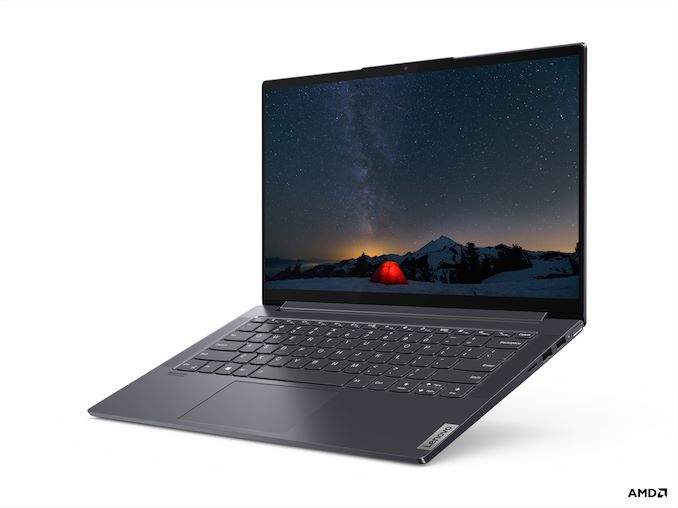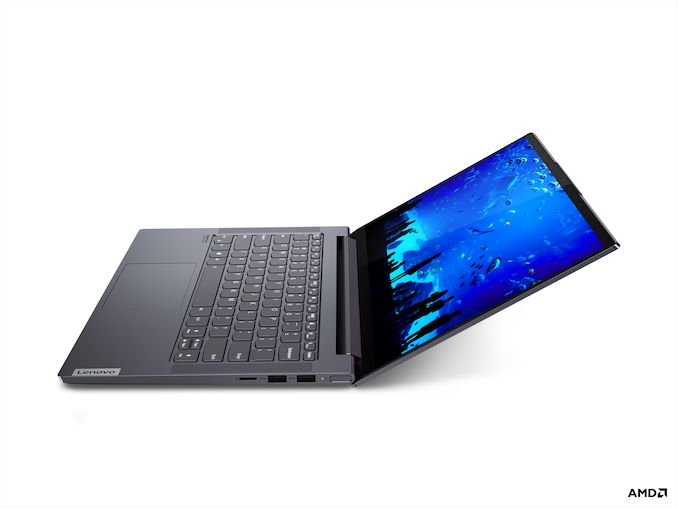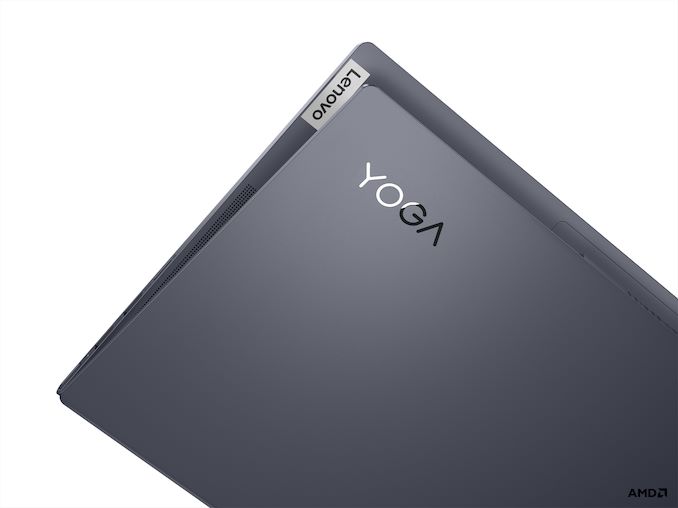CES 2020: Lenovo Yoga Slim 7, with AMD 4000 APU inside, Coming March
by Dr. Ian Cutress on January 6, 2020 2:45 PM EST- Posted in
- Laptops
- AMD
- Lenovo
- Trade Shows
- Notebooks
- APU
- CES 2020
- Yoga Slim
- Ryzen 4000

One of the big questions through late 2019 was whether AMD would be releasing its newest Zen 2-based mobile processors by the end of the year. At the time this embargo lifts is AMD’s press conference at the annual CES trade show, and we should know more. But in advance of that announcement, Lenovo provided us a pre-briefing where it gave us details about its new Yoga Slim 7 laptop, featuring one of the new processors. The release date for this unit is listed as March, which matches the other devices showcased by other OEMs with the same processors.
Lenovo’s Yoga Slim range prides itself on offering full-sized mobile devices in a ‘thinner-than-you-expect’ form factor for the price. The Yoga Slim 7 being discussed today at CES with AMD’s Ryzen 4000 inside is a 14-inch display device featuring a 1920x1080 IPS display, offering up to 16 GB of LPDDR4X memory, up to a 1 TB NVMe SSD, two USB 3.2 ports, one multi-mode Type-C port, 802.11ac WiFi, and an IR camera, all for 14.9 mm thickness (0.58 inches).
Prices will start at $699, although that doesn’t state which processor/memory/storage configuration that would be. The battery comes in at 60.7 Wh, which Lenovo is stating should be good for 14 hours, which would be a sizeable uplift in mobile battery efficiency from AMD.
There will also be an Intel version with similar specifications, with only the Ice Lake Core i7-1065G7 CPU as an option, but otherwise similar specifications (an optional NVIDIA MX GPU) and similar battery life estimates. The difference is that one starts at $1210, and will be in the market from April 2020.
We will hopefully get some hands on with the devices at CES, so stay tuned for more information.



















12 Comments
View All Comments
nandnandnand - Monday, January 6, 2020 - link
4, 6, or 8 cores in the AMD version? A 15-Watt TDP 8-core was rumored...yeeeeman - Monday, January 6, 2020 - link
It would run at very low speeds all core, so a bit useless.neblogai - Monday, January 6, 2020 - link
Not useless, as cores can run at lower voltage then, thus performing better in multithreaded tasks- as proven by Intel's 15W 6-core.uzzi38 - Monday, January 6, 2020 - link
https://videocardz.com/newz/amd-introduces-renoir-...1.8GHz base. It'll be fine.
Sahrin - Monday, January 6, 2020 - link
IPC v. Clock.Why is it people seem to struggle so mightily with these concepts?
nandnandnand - Monday, January 6, 2020 - link
It's confirmed. And it would be a lot better than what I have now.deksman2 - Monday, January 6, 2020 - link
Not necessarily.Zen 2 has high IPC and quite good efficiency.
Someone posted leaked Userbenchmark scores of 4800U (8c/16th Zen 2 Mobile) APU scoring between Ryzen 2700 and 2700x (in a 15W TDP - which is normally configurable to 25W).
The thing is, we don't know if those results are accurate or not... we'll have to wait and see.
Also, if the unit doesn't have a dedicated GPU, then its possible it will be TDP constricted to 15W and the cooling will be so poor it will barely allow the unit to sustain baseload speeds.
OEM's previous attempts at creating a laptop with only AMD apu resulted in sub-par cooling which also affected performance because they couldn't be bothered to create adequate cooling for an APU to operate at its maximum indefinitely (which is more than possible).
Only cases where we noticed the AMD APU was able to maintain its boost clocks and operational performance was in cases where it was paired with a dedicated GPU.
Otherwise, if the unit only had an APU, the cooling was usually poorly done.
StevoLincolnite - Monday, January 6, 2020 - link
I noticed with my 2700u if I throttle back the maximum CPU clock, more TDP got funneled into the IGP resulting in an uplift of gaming performance.Heat wise, never really noticed any issues, but that TDP wall was real.
zodiacfml - Monday, January 6, 2020 - link
No. That's so 10 years ago. As most applications are multi-threaded, one would opt for more cores in limited TDPs such as laptops or smartphones. Low core speeds are power efficient.cigar3tte - Monday, January 6, 2020 - link
Would like to know the weight too.